AI Generated Abstract - This article explores the historical connections and speculative theories surrounding the Sabbatean-Frankist movement and its influence on prominent families, particularly the Rothschilds, throughout history. It delves into the secretive and controversial practices of the Sabbatean-Frankists, a small sect with Luciferian leanings that allegedly infiltrated various religious and political spheres. The article examines the ties between the Rothschild family and other influential figures, such as Louis Brandeis and John Slidell, suggesting potential Sabbatean affiliations. It also discusses the broader impact of Sabbatean and Saint-Simonian philosophies on global events, including the construction of the Suez Canal and the Zionist movement led by Theodor Herzl, offering a novel perspective on the interplay between religious sects, economic power, and historical developments.
Summary and General Premise Bullet Points:
There are many Internet assertions that the Rothschilds were, and may remain, members of a secret Luciferian cult known as the Sabbateans or Sabbatean-Frankists.
We do not disagree with those assertions, but nevertheless believe the evidence is ‘thin’, mostly circumstantial, and repeated ad nauseum, which does not make the circumstantial evidence any ‘thicker’.
If there is some documented evidence, we have not seen it, nor would we expect it to. Nevertheless, we believe the circumstantial evidence presented below strengthens the circumstantial evidence cases that exist as it presents another avenue of investigation that we have not come across yet.
The Sabbatean movement, which peaked in popularity around 1666 amongst European and Middle Eastern Jews, never completely dissipated.
Jacob Frank, Sabbatai Zvi’s self-proclaimed reincarnated successor, ramped up the more debauched rites of the original Sabbatean cult, and we believe successfully roped in many Catholics, mostly weighted towards eastern Catholic denominations such as the Ukrainian Greek Catholic Church. See End Notes [A]
Sabbatean-Frankists are, therefore a small cabal of Luciferians posing as Jews, Christians, and Muslims (see the Dönmeh of Turkey).
The blame for the satanic agenda and practices of the small but powerful cabal is usually shifted to the mostly unaffiliated Jewish population so that critics and inquiries can be labeled as anti-Semitic conspiracy theorists.
Since Sabbatean-Frankists only pose as other religious adherents and are composed of very small minorities of Jews, Christians, and Muslims, it is easy for believers to profess, and for observers to accept, that the cult disappeared centuries ago and is therefore irrelevant today.
In the context that a few powerful families were able to obtain huge fortunes as devotees of a cult that encourages immorality and anti-social norms, we lean towards the conspiracy theory that practicing Sabbatean-Frankists still exist, and they are still causing problems.
That is, it was easy to get rich selling opium to Chinese peasants, or Africans to plantation owners, when the immorality of those miserable markets is avoided by moral people, and because there exist mainstream religious prohibitions against making money off the misery of others. Moreover, as a final disincentive for individuals lacking a moral compass, or ignore religious prohibitions, laws exist to punish those individuals.
There is a more nuanced economic argument for why some powerful families persist for centuries while most only last decades.
Market forces will typically eliminate the outsized profits enjoyed by families conducting legitimate business because there is nothing unethical or illegal about a competitor building a better mousetrap.
Those powerful families that have built fortunes on the misery of others, however, are able to enjoy monopolies in misery markets because most potential competitors will avoid those markets.
Potential competitors either avoid misery markets because they are found to be personally morally repugnant, or in the absence of personal ethical prohibitions, societal forces find certain markets immoral and enact laws to prohibit engagement.
That the Sabbatean-Frankists mostly practice in secret, and when occasionally discovered, are adept at framing allegations as nothing but the delusional rants of anti-Semites, making it hard to point to an actual evil agenda, let alone its primary actors.
Secrecy and subterfuge notwithstanding, families with fortunes that never seem to succumb to market forces over the centuries should raise suspicions.
The Usual Suspects
The Rothschild banking family checks many boxes that suggest they are Sabbatean-Frankists, or at least were at one point. Armchair accusers usually point at the same surface-level evidence repeatedly, which is mostly circumstantial, though not necessarily incorrect.
The identification of Sabbatean families that have remained powerful up to modern times does not seem to extend much beyond the present-day Rothschilds.
Whether today’s Rothschild clan members are practicing Sabbatean-Frankists, or whether some or all of them washed their hands of the cult decades ago, they have plenty of legitimate investments to keep themselves far removed from illegitimate activities that might eventually have negative consequences if a connection between those activities and the family could be found.
Basically, there are other Sabbatean-Families out there that are probably closer to the every-day operations of the global crime syndicates, and the every-day machinations of promoters of genocidal agendas, than the current clan of Rothschild heirs.
Nevertheless, we believe it is worthwhile to attempt to firm up the Rothschilds' associations with Sabbateanism beyond the same limited and repetitive assertions that show up in five-minute YouTube documentaries or 200-character tweets.
The need to keep secrets probably explains why assorted 18th-, 19th-, and early 20th-century Rothschilds found their first and second cousins so attractive that they regularly exchanged marriage vows.
Internet Sleuthing and Other Families
Aside from the Rothschild family’s fabulous wealth, which suggests illicit origins, 'bloodline' analyses and Babylonian legends do not really move the needle for us. The photo of John Podesta’s ‘Witch’ lady friend Marina Abramovic standing in front of the painting "Satan Summoning His Legions” with Jacob Rothschild may be as ominous as it looks. On the other hand, maybe it’s how billionaires troll the conspiracy-minded crowd.
Satan Summoning His Legions - Artist: Sir Thomas Lawrence (1769 - 1830)
Even though the Rothschilds’ supposed Sabbatean leanings are mostly conjecture, or are based on circumstantial evidence, there are a few families that are definitely or highly likely Sabbatean or one or more of its derivatives (Frankists) or sub-sects, (the Dönmeh).
One family name worth mentioning, and before we go further back in European history, I Brandeis, as in Louis Dembitz Brandeis (1856 to 1941), Associate Justice of the Supreme Court of the United States from 1916 to 1939. His parents, Adolph Brandeis and Frederika Dembitz, were Frankist Jews. [1]
Louis Brandeis also kept a portrait of Eva Frank, the daughter of the founder of Frankism, Jacob Frank.
“In 1770, following the death of his wife, Jacob refocused his divine feminine decrees on nearly 16-year-old Eva. He declared her to be the Messiah and the reincarnation of both the Virgin Mary and the Shekhinah, the divine presence on Earth, interpreted as feminine in Jewish mysticism.”[2]
Eva Frank, Jacob Frank’s daughter to 1754 to 1816.
Eva Frank’s status as a female messiah, as declared by her father, is worth highlighting, as the concept of a female Messiah comes up again 60 years later.
Another family name that does not require a historical look-back of too many centuries is “Slidell”, as in John Slidell, Louisiana Senator from 1853 to 1861 and Confederate Diplomat during the Civil War. [3]
We have come across a few mentions that John Slidell was a Sabbatean-Frankist, but we have not found a reliable citation. Slidell’s family and business connections point toward easily possible affiliations with the cult.
His daughter, Marguerite Mathilde Slidell, was married to Frederic Emile d'Erlanger, the son of Raphael von Erlanger, the founder of the investment bank Erlanger & Sons and a former partner of the Rothschild Bank in Frankfurt. It was Erlanger & Sons of Paris that underwrote the Confederacy’s first foreign bond issue, which John Slidell negotiated. See End Notes [B]
John Slidell’s sister, Jane Slidell, was married to Commodore Matthew Calbraith Perry. [4] (Perry may be the Anglicized version of Pereyra, which is associated with a wealthy supporter of Shabatai Zvi from Amsterdam and, prior to Amsterdam, with the exiled “Converso” (Iberian Jews who converted to Catholicism, forced or otherwise) families of Portugal.)
John Slidell’s niece, Caroline Slidell Perry, the daughter of Jane Slidell and Matthew Perry, married August Belmont, financier, Rothschild agent in North America, and Chairman of the Democrat National Committee, from 1860 to 1872. [5] The Belmont family, originally Belmonte, were Portuguese Conversos by way of Amsterdam and Alzay in modern Germany.
August Belmonte - DNC Chairman (1860 - 1872) - Rothschild Agent
The Unusual Suspects
We have not come across much information about Sabbatean-Frankist recruitment processes, but the religion/cult would not seem to lend itself to “missionaries” having an easy time finding new converts.
Therefore, the number of Sabbatean-Frankist families that have come and gone, or come and persisted, should be small because there were never many families to begin with.
Moreover, the families would tend to only marry each other, since conversion to a cult with Satanic leanings would be a tough sell to outsiders. Finally, incest was not an apparent deal-breaker and may have been encouraged.
Even though the Rothschilds are believed to be Sabbatean-Frankists, there is not much in the way of direct tangible evidence to say they were with absolute certainty. Nevertheless, there may be some families, connected through marriage to the main Rothschild branch, that are more provably Sabbatean than the Rothschilds themselves, with an acknowledgement that the cults’ practices are objectionable enough to cause individual family members to find a different religion.
Strongholds of Sabbatean fanatics in Europe, included the cities of Izmir (Smyrna) and Salonica (Thessaloniki) in the Ottoman Empire, Galicia (Southern Poland, Western Ukraine), and Prague, being frequently cited.
The city of Amsterdam was another stronghold and is a good place to start when looking for Sabbatean family names, especially those that ended up in the Americas.
Old Amsterdam
Many Sephardic Jews of Spain and Portugal that were converted by force in 1492 and 1496 respectively, eventually made their way to Amsterdam. (The Ottoman Empire was the most favored destination.)
These “Conversos” began to settle in Amsterdam after 1536, when the Inquisition was established in the Kingdom of Portugal, and simultaneously, travel restrictions were eased for Conversos living in Portugal.
The messianic ramblings of Sabbatai Zevi, and his heavy reliance on kabbalistic mysticism, made it especially attractive to Amsterdam’s Converso community, who were used to posing as Christians to avoid persecution as Jews or as suspected Jews by the Inquisition while living in Portugal.
Additionally, forgetting where we heard or read one academic’s ponderings, so no attribution, the Spanish and Portuguese Inquisitions and conversions caused enough societal upheaval and personal angst among Sephardic Jews to consider that ‘The end must be near’, prompting many to turn to the Kabbalah and its mystic orientation for explanations that the local Rabbi could not provide.
Finally, up until 1674, or about eight years after Sabbatai Zevi reached peak popularity, the Ashkenazi population of Amsterdam was small, so pushback by traditional Rabbis against the antinomian ideas of the false messiah narrative was initially minimal.
Even when sizable Ashkenazi populations began to arrive in 1674, mostly as poor refugees escaping Polish pogroms, the smaller, but more established and financially secure Sephardic community maintained a higher degree of influence over religious and secular issues compared to the newcomers. [6]
Pereyra, Pereira, Pereire, Perry, etc.
One of the names that even shows up in Wikipedia as a fanatical Sabbatean from Amsterdam is Abraham Israel Pereyra (died 1699).
From a different perspective, and at a later point in Pereyra's life, Gershom Scholem adds that circa 1674, the followers of Sabbatai Zevi in Amsterdam,
"…used to meet in the house of their leader, Emanuel Benattar, the hazzan of the Portuguese Synagogue, and seem to have been unmolested by the Jewish authorities, possibly because they had the very pious and very wealthy Abraham Pereyra…"
as one of the prominent members in their group. [7]
Abraham Pereyra was born in Madrid to wealthy Converso parents and is believed to have arrived in Amsterdam around 1644. He and his brother Isaac made a significant amount of money in the sugar trade and
“… occupied an important place on the Exchange [Bank]. The reference here is to the Amsterdam Stock Exchange, the oldest stock exchange in the world, started by the Dutch East India Company /VOC in 1602.” [8]
We could make this a book instead of an article to try to connect Abraham Pereyra, a documented Sabbatean, to the Rothschilds.
To keep this manageable though, we will only note that there is at least one Pereyra in the Rothschild family tree and a few Pereyras in families closely connected to Rothschild business interests.
Jacob Rodrigues Pereira, who was a Spanish Converso with Portuguese origins. Upon moving to France, he adopted the French spelling of Pereira, which is Pereire.
His grandsons, Emile and Isaac Pereire,
“…were major figures in the development of France's finance and infrastructure during the Second French Empire …” [9]
The brothers founded Credit Mobilier bank in 1852 and were considered the Rothschild bank’s main rival in France during the Second French Republic (1852 to 1870). Issac’s son Eugene took control of the bank in 1880.
His daughter Noemie married Maurice de Rothschild in 1909. [10]
Aside from the Pereire brothers’ business interests, they were followers of the now obscure quasi-religious philosophy of the Saint-Simonists.
In our opinion, some versions of the Saint-Simonist philosophy sound suspiciously Sabbatean.
Saint-Simonism Sound Like Sabbateanism
Founded by Henri de Saint-Simon (1760 - 1825) a French political, economic and socialist theorist and businessman, Henri believed the needs of the working classes required attention for society to function. More succinctly, if the rich people ignore poor people, those poor people are going to rise up and kill the rich people someday. [11]
During his later years and after his death, the philosophy of Saint-Simon subsequently evolved into a number of different iterations, one of which included a co-leader and French civil engineer, Prosper Enfantin (1796–1864).
It was not long before Prosper declared that he was 'chosen by God,' and provided predictions of the imminent arrival of a female Messiah. Another one of his other declarations was 'marriage is tyranny'.
He was also accused of running a brothel, promoting 'free love,' and dressing in women's clothing, all of which soon led to an indictment for 'endangering public morality,' prompting a pilgrimage to Turkey circa 1832, where Shabatai Zvi got his start and where the Dönmeh never disappeared.
“Enfantin led his followers to Constantinople, who were the same people whose visit Goodell witnessed. The Simonians did not respect the Sultan in the way they should have, not bowing to him and instead bowing to women in the street. Their wish, according to Goodell, was to find the female messiah by comparing the women to an idol in their possession. [12]”
After Enfantin was done making a nuisance of himself in front of the Sultan, he set out for Egypt with the idea of pitching the Suez Canal to the Ottomans’ top man in Egypt, Ibrahim Pasha.
Prosper Enfantin was actually a trained engineer, but his sales pitch to the Egyptians included a lot of sexual symbolism and canal comparisons to the female anatomy, and he was eventually sent packing without a canal deal.
There are more Prosper Enfantin stories that involve both sober stories of engineering competency with respect to canals and construction projects, and sordid tales of “look at me, I’m a cross-dressing libertine, looking for some ladies to worship and grope.”
The combination of engineer and occultic-swinging-pervert seems very familiar these days, since there seems to be a confluence of mixed-gender sexual fixations and people-replacing technologies among the leftward-leaning elitist set today, which seems suspiciously similar to Prosper Enfantin and the leftward-leaning Saint-Simonist set that existed in 1830s France.
It has also been noted that Saint-Simonian ideas exerted a significant influence on new religious movements, such as Spiritualism and Occultism, since the 1850s, as well as socialist utopian societies. Karl Marx considered the Saint-Simonians to be the "patriarchs of socialism." [13]
Little St. James Sidetrack
Since we’re on the subject of socialists mixing sex, spirituality and technocracy we can’t help but wonder if there is a Jeffrey Epstein connection to the St. Simonians.
Maybe there is actual evidence in some archive somewhere, or maybe we’re speculating too wildly, but it would be interesting if Prosper Enfantin or his band of perverted French civil engineers ever passed through Aleppo, Syria, while traversing the Ottoman Empire.
Aleppo was a stop for Sabbatai Zvi in his recruitment campaign. The large Sephardic community there would have made it a worthwhile destination.
Aleppo is also where a familiar building that has existed since the 15th century and still exists today (the ISIS war in Syria only recently partially destroyed the building.) Known as the “Hammam Yalbugha”, it was a public bathhouse (Turkish bathhouse) for most of its existence.
📷
As mentioned, the Pereire brothers were followers and promoters of Saint-Simonist (aka Saint Simonians) ideas. A French newspaper called The Globe, which was only in print from 1824 to 1832, became the primary publication of Saint Simonist ides and received financial and editorial assistance from the brothers. [14]
Another key tenet that evolved from the core belief that the working classes cannot be ignored was an early version of the need to create technology-governed societies (Technocracy).
The term, at the time, was “Industrialism” and the underlying idea was that the hoi polloi classes, to which the Rothschild and Pereire families belonged, should create industries, or build massive public works projects to keep the masses too busy toiling to revolt.
The desire to keep the proletariat busy appears to be a major part of the rationale behind the significant early support (late 1820s and early 1830s) that French aristocrats gave to the idea of building the Suez Canal. (Compagnie de Suez, a company formed by “Saint-Simon sympathizer” Ferdinand de Lesseps, specifically, to build the canal, began construction in 1859 and finished in 1869.) [15]
Herzl Historical History Rewrite
The current situation in Israel, with respect to Zionism in a historical context, seems to leave out a lot of history within both the ‘for’, and ‘against’, camps.
Whatever historical narrative either side is attempting to construct, references to Zionist activities prior to 1896/1897, the years Theodor Herzl published his first pamphlet (Der Judenstaat)[16] and organized the First Zionist Congress in Basel, are rarely mentioned.
Theodor Herzl (1860 to 1904), the founder of the modern Zionist movement was not always focused on establishing a homeland for Jews suffering from persecution or those expecting persecution in the future.
According to “A Man Alone: The Life of Theodor Herzl”, by Andre Chouraqui, Theodor, at about the age of ten, was an admirer of Ferdinand de Lesseps, the Suez Canal builder, and was inspired to build his own canal.
Since the Suez Canal was just recently completed, and Theordor decided he would build the Panama Canal. Theordore’s father, a businessman who comes across as a busy guy, was apparently less than impressed with Theodor’s Suez Canal dreams, but became somewhat impressed with his son’s obsession with building the Panama Canal and sent him to the Technical School of the City of Pest (Hungary). [17]
The story of young Herzl, if it is even true, could probably be summarized as;
“Busy dad sends annoying son to learn some math to become an engineer and maybe build the Panama Canal someday, but at the very least earn an engineering degree.”
Herzl lasted five years at the technical school.
Even though Herzl never got to build the Panama Canal (he graduated with a law degree and worked as a journalist and playwright) as a journalist he covered the first failed French Panama Canal effort by his favorite canal builder Ferdinand de Lesseps and then the second failed French effort by the successor to the first bankrupt company.
In one of his works of fiction, Herzl envisions a canal cut through Palestine (present day Israel) to connect the Mediterranean and the Dead Sea.
In the accolades given to Herzl for his heroic efforts to protect Jews from prosecution, his briefly considered plan to move European Jews to Uganda, which is in the middle of Africa, is lauded for its creativity, no matter how stupid the idea sounds.
We would argue that Herzl’s Jews to Uganda motivation had very little to do with protecting persecuted Jews and more to do with the Dam and Canal building potential the St. Simonians would acquire if they only controlled the map.
Animists, Muslims, Protestants, Catholics, Let's throw in some Jews. The Uganda Plan.
Map of British Protectorate of Uganda showing original and expanded borders. Established June 1894. Uganda Independence - October 1962.
Uganda sits on the north Shore of Lake Victoria, the source of the Nile. It is bordered by other large lakes and water-transportation is involved in all aspects of commercial activity.
Even in the late 1800’s it was a dam and canal builders paradise. Since Herzl articulated his “Uganda Plan” 130 years ago, many large dam and canal and railroad projects have been completed.
Prior to 1894, Uganda was the Kingdom of Buganda. The kingdom came under the administration of the Imperial British East Africa Company (IBEAC), when it was chartered in 1888.
The four religious factions that lived in the Kingdom spent a lot of their time fighting each other for control of the region and were otherwise 'ungovernable' so the IBEAC ceded control to the British Government. Uganda became a Protectorate of the British Empire in 1894.
The four factions were “native religionists”, Muslims, Protestants and Catholics.
The conventional narrative, that Herzel thought throwing Eastern European Jews into that mix would somehow make them safe, does not make any sense.
That Herzel saw Uganda's potential for huge public works projects, we believe, makes more sense.
In 1903, Herzel formed a Commission to propose a plan to build a massive aqueduct to irrigate the parched Sinai desert with water from the Nile River. (The impossible engineering required to build a massive aqueduct that transects the massive Suez Canal meant that the project never went very far.) [17]
This is all to say that Herzl’s purported enthusiasm to find a haven for Jews may just as well have been cover for St. Simonists to maintain control over the lower classes with big, expensive, public works projects.
While, greening the Sinai dessert would certainly be beneficial to Jews looking for a homeland, digging a canal across northern Columbia (present day Panama) or through Nicaragua, probably was not going to help many Jewish families worried that the Czar’s secret police might come knocking sometime soon.
Neither would dropping European Jews in the middle of the Eastern Congo (Uganda) where four religious factions were already reliably making violence against each other.
To that end, the story about young Theodor Herzl, annoying his dad about building a monstrous canal in the South American jungle, therefore is probably just a story concocted to obscure “adult” Theodor’s involvement in promoting St. Simonism.
It’s hard to tell if Herzl was a dedicated St. Simonist or more of a hired gun (promoter) for the Rothschilds and related families. Even if he was a dedicated St. Simonist, it’s possible he was unaware of any Sabbatean similarities to St. Simonist ideas. Herzl, never-the-less, was aware of Sabbatai Zvi.
As Herzl’s push for a Zionist homeland gained traction in 1895-1896, he was both warned and encouraged that his status was reminiscent of Sabbatai Zvi. [19]
March 29
“Seder of the Jewish student association Unitas. Friedmann, a lecturer at the University, explained the history of this festival which, after all, is our most beautiful and most meaningful one. I sat next to him. Later he spoke briefly with me in private, reminded me of Sabbatai Zvi, ‘who enchanted all people,’ and winked in a way that seemed to say that I ought to become such a Sabbatai. Or did he mean that I already was one?”
Maybe the Main Motivation, Maybe Another
The main motivation for the creation of a Jewish homeland, as the existing narrative goes, from the late 19th Century forward, was to alleviate the persecution of Jews. There is not much objectionable about the idea either now or then. The main objections to a Jewish homeland, now, mostly arises over the displacement of local populations already there.
The displacement of Palestinians was hardly of concern 125 years ago. The Europeans had been displacing locals all over the world since 1492 and the Americans were nearly done “Manifest Destining” the Indians from the land they occupied for the previous ten thousand years.
We submit that the actual motivation was to fulfil the St. Simonists dream of creating a utopia for the world’s elite, which relied heavily upon Sabbatean ideas as to how the world should be managed.
St. Simonism may just have been a secular version of Sabbateanism, and as so, more accessible to the royal families of Europe, or other men of means who were Christian. Wealthy Jews, Sabbatean or not, and wealthy Christians, nobility and Church leaders, could all participate in St. Simonist plans without the need to obscure religious affiliations.
If finding Jews a homeland was and remains the public narrative, and St. Simonism was and remains the underlying motive to control the Levant (see Israel’s Gaza Canal project), the ultimate motivation may just have been, and remains, money.
The St. Simonists came from the moneyed classes but were not so rich as to finance billion-dollar public works projects themselves. They were the educated and skilled executives who worked diplomatic channels for years to acquire concessions from sultans and regional governors. They were engineers and construction firm managers with the technical knowledge to build big things.
The Pereire family, and the Rothschild family, and maybe a handful of others were the investors with the capital, without which, no giant Canal would be built anywhere. Even though we think the Rothschilds and Pereire families were Sabbateans, and supporters of the St. Simonists, it is possible they could have just cared about earning worthwhile risk-adjusted investment returns and financing the construction of a canal from the Red Sea to the Mediterranean penciled out.
As mentioned, the Pereire brothers never disguised their St. Simonist interests and received most of the “credit” for providing the credit to construct the Suez Canal from (1859 to 1869.) The French Rothschilds also provided equity and credit for construction and in 1875 the English Rothschilds helped the British Government buy-out the 44% Suez Canal Company stake owned by Isma’il Pasha, aka “Ismail the Magnificent”, the Khedive (Viceroy, Governor) of Egypt for the Ottomans. [20]
Although the modern Zionist movement is mostly presented as an organic emergence of an effort to protect poor, persecuted, Eastern European Jews, there is acknowledgement that the better off and mostly assimilated Jews of Western Europe were motivated by additional factors.
These factors include nationalism, appreciation for Age of Enlightenment principals, and incidents of anti-Semitism in the upper classes, such as the Dreyfus Affair in France, which kicked off in 1894 and was a major political, legal and social matter in worldwide well past its official resolution in 1906.
The plight of Eastern European Jews was not enough to prompt serious consideration in Western European establishment enclaves, such as mercantile and banking circles (Jewish and otherwise), noble and royal families, and ruling class Catholic and Protestant agenda setters until the Dreyfus Affair laid bare more relatable forms of anti-Semitism. (Elements of the more evangelical Protestant clergy, like today, were particularly supportive of turning Palestine into a Jewish homeland, both because of all the Eastern European Jews it would save, and the prophecies it would fulfil; but probably mostly the latter.)
The 1890s emergence of modern Zionism was probably less organic than how it is currently presented. In addition to Palestine’s close proximity to the best place in the world to build a canal, if you were wealthy a mercantile family in the Eastern Trade, or a Saint Simonist looking for a giant project that will keep the unwashed masses busy toiling for at least the next 10 years, or both, buying up as much land as possible in the near vicinity of where the canal will go would be prescient.
Decades before ten-year old Herzl (circa 1870) was bothering his dad about canals the always prescient Rothschilds were making moves in the Middle East. The interest even proceeded that of Herzl’s most admired Civil Engineer, Ferdinand de Lesseps.
According to the official narrative, Ferdinand’s interest in building a canal began as a French diplomat in Alexandria, Egypt in 1832, after reading about an ancient, failed canal digging attempt written by a French engineer during Napoleon Bonaparte’s occupation of Egypt circa 1800. [21]
In October of 1829, a number of British newspapers published a purloined private letter, supposedly written by Baron Rothschild, that offered to buy;
“the sovereignty of Jerusalem, and the territory of ancient Palestine…” from the Sultan, for the “…enormous sum of 350,000,000 piastres, in three installments…”,
or roughly, with the help of ChatGPT, $70 million in 1830s U.S. dollars, or roughly again, $1.2 trillion in 2024 U.S. Dollars. ([C] See end notes for clipped article.) [23]
As Theodor Herzl would argue 60 years later, the reason why Baron Rothschild wanted to buy the Holy Land for $1.2 trillion was because of the persecution of European Jews.
The Rothschild letter and it's understandable rationale appeared at about the same time the Saint-Simonists were coming into some money (they bought The Globe in 1830) and exerting some influence.
It looks like another one of those coincidences that conspiracy theorists should view suspiciously.
Notes:
[A] - Ukrainian Catholicism (officially, the Ukrainian Greek Catholic Church), Bulgarian Catholicism and a few other similarly named forms of Eastern Catholicism are distinctly neither Roman Catholic, nor Eastern Orthodox.
These Churches are “in full communion with the Holy See.” [22] (In this case, “Full Communion” means “in agreement” with the core principals of the Roman Catholic Church as opposed to the Ukrainian Orthodox Church.)
The Ukrainian Greek Catholic Church came under the jurisdiction of the Vatican in 1596 and is the largest Eastern Catholic church that follows Byzantine (aka, Greek) rites, with about 18 million members.
Ukrainian Nazi, and my top choice for Frankist-posing-as-Catholic, Stefan Bandera was a Ukrainian Catholic. His father was a priest. (Roman Catholic priests cannot marry. Ukrainian Catholics priests can.)
[B] – Those that are interested in “out-there” conspiracy theories might appreciate that Wayfair, the internet store that was accused of selling kids through its on-line catalog, has one of its major distribution hubs in Erlanger, Kentucky, which is named after Friedrich Emil Erlanger, who helped, via the family bank, finance the construction of the railroad.
[C]
Citations:
2- Telushkin, Shira. "Meet Eva Frank: The First Jewish Female Messiah." JSTOR Daily, 27 April 2022.
4- Matthew C. Perry - Wikipedia
6- History of the Jews in Amsterdam - Wikipedia
7- Abraham Pereyra - Wikipedia
8- Ibid
9- Pereire brothers - Wikipedia
10- Ibid
11- Henri de Saint-Simon - Wikipedia
12- The representation of the Ottoman Empire in the memoirs of Pliny Fisk and William Goodell.
13- Henri de Saint-Simon - Wikipedia
15- Ferdinand de Lesseps - Wikipedia
22- Ferdinand de Lesseps - Wikipedia
23- Liverpool Mercury, etc. (October 30, 1829). Rothschild - Palestine Offer to buy; October 1829..
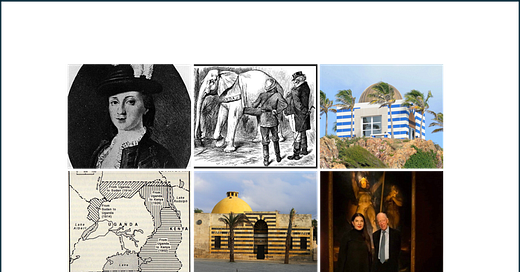



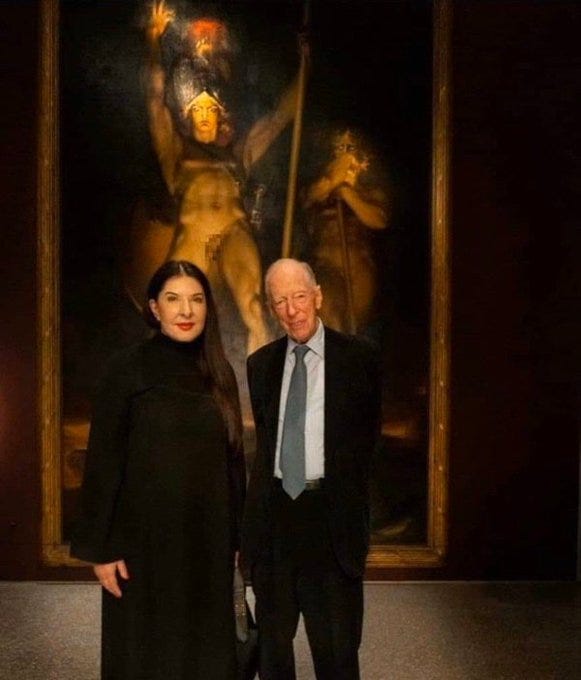
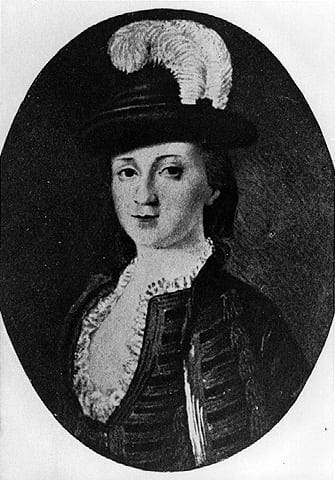
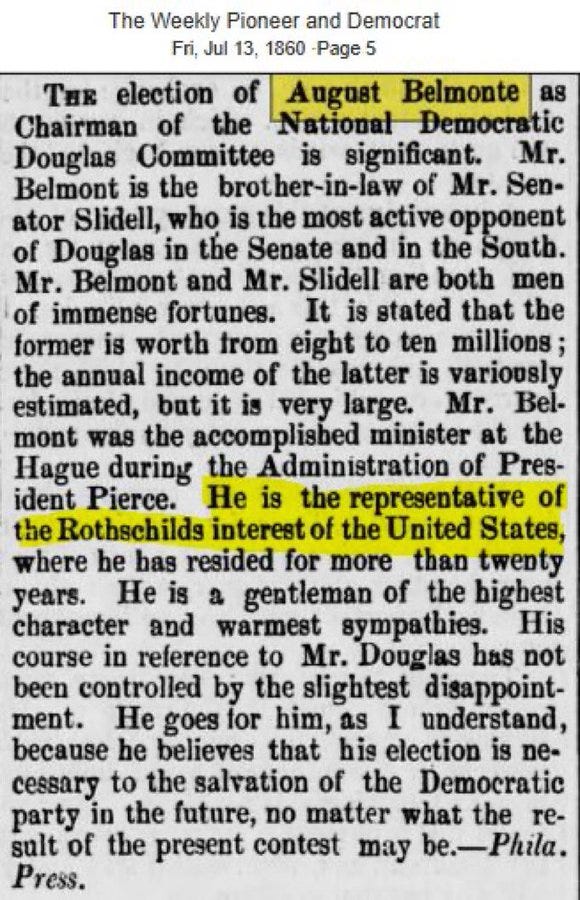

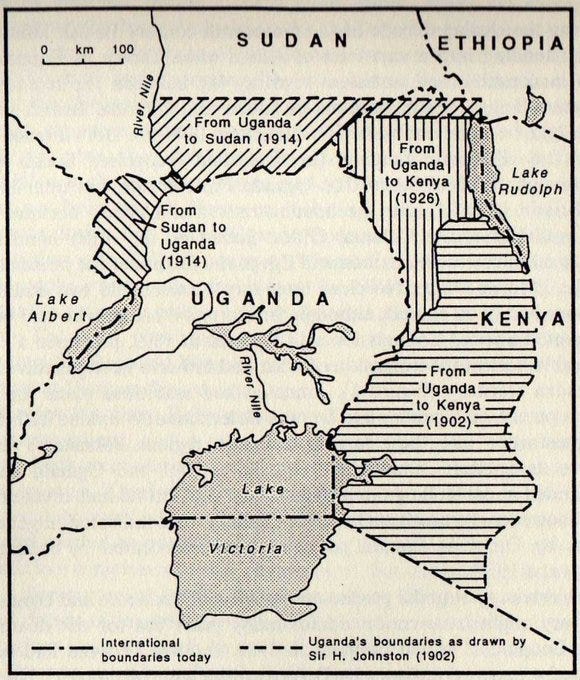
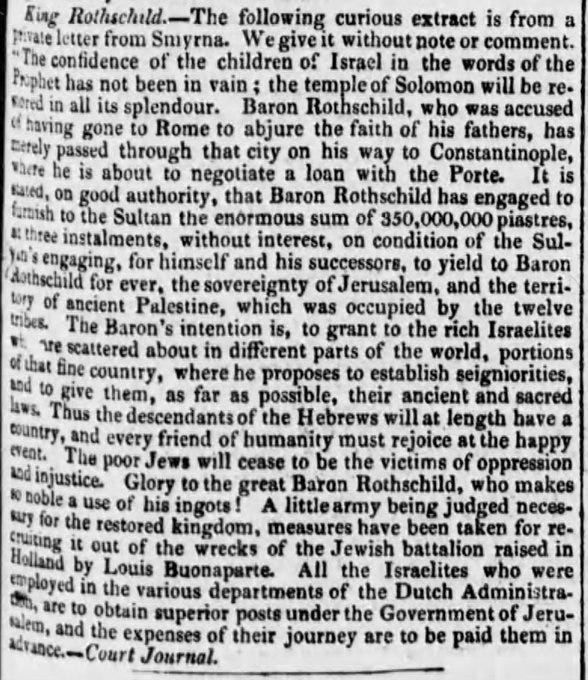
Thank you!
Your article gives great insights as to the origin of the Globalist Dictatorship project now in full swing, with their DEI ideology and supposed left wing inclination.
The interest in owning the Holy Land has deeper roots in the World Domination Imperium War Elite now attempting the Final Coup in Palestine.
Interesting take on things, this furthers our insight on that matter.
I'd like to know what counter power structure are in play that perpetrating the same kind of thing in their own right, state. I hear the Khalifa is in contender for world domination, some Asiatics are eager to take over...
In my book it's the hippies that win and rally everybody despite their differences, in the end. #jointheresolution